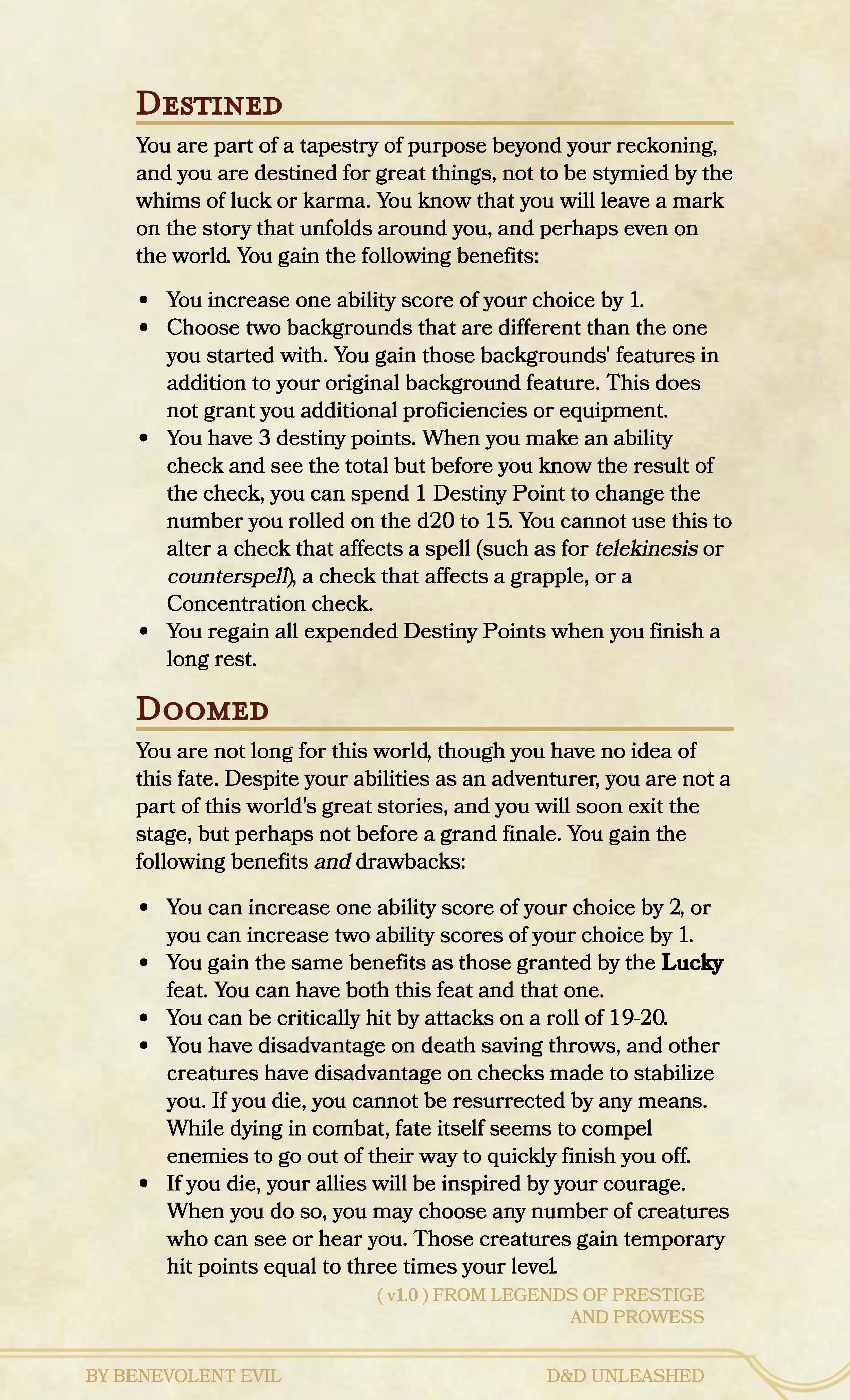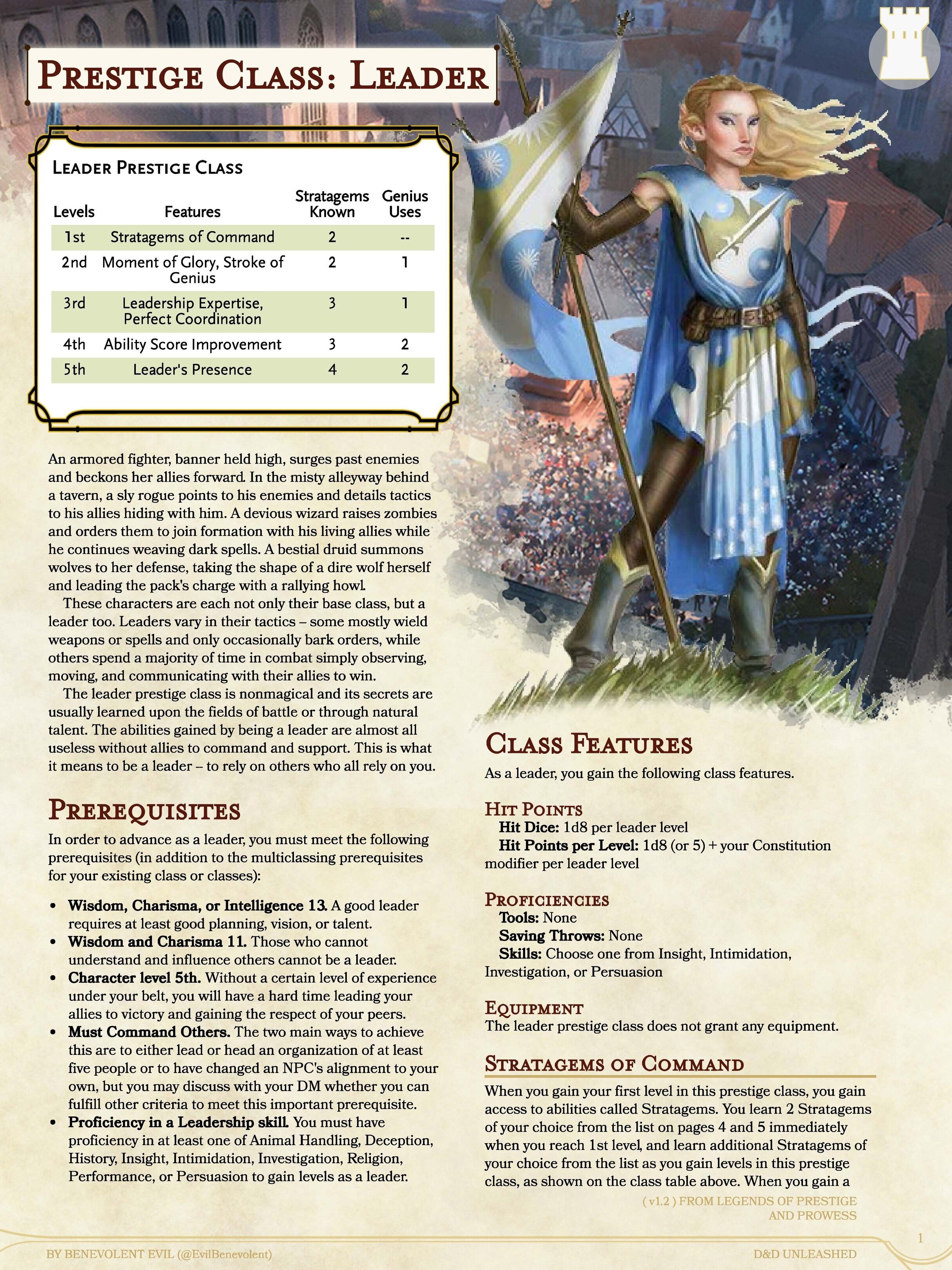Example Character: Fighter / Leader
The Leader Prestige Class — which will be part of the Legends of Prestige and Prowess compendium — has finally been previewed in full for the first time! With it comes the most iconic example character for the Leader, a Fighter / Leader. The idea behind example characters for prestige classes is that just a small selection of character choices can illustrate the power, flexibility, and theming of a prestige class in ways that simply seeing the material often can’t.
We’ll be calling this example character The Warlord, in honor of its roots in the design of the 4e warlord class. Like most of the example characters we’ll see for the Leader, this PC is level 10. That’s just enough levels that a PC could have finished all 5 levels of the Leader prestige class, but not every example character is maxed Leader. The Warlord, however, is.
First, the Warlord must have 5 levels in other classes to meet the prerequisites for taking levels in Leader. It isn’t important for this example to define a particular race for this character. Let’s assume Intelligence is their dump stat, and that they have at least an 11 Charisma and 13 Wisdom to meet the prerequisites for Leader. Knowing that they will specialize in defense and support, the Warlord picks up a defensive fighting style such as Protection or Armored, and wields a one-handed melee weapon along with a shield. There are many good options for a fighter subclass that allow the Warlord to do Leadery things before they can actually take levels in Leader, like some of the maneuvers available to the Battlemaster subclass. In this example we’ll be building the Warlord with the less complex but wonderfully thematic Purple Dragon Knight subclass from the Swordcoast Adventurer’s Guide, which involves fewer choices but still lets the Warlord support and inspire their allies in a nonmagical way.
At 4th level the Warlord might take a regular ability score improvement, or they might take a feat that makes them tougher or a thematic feat that supports the group (such as Inspiring Leader). At 5th level they gain the all-important Extra Attack. Then when the Warlord finally reaches 6th level, they can make that their first level in Leader. For doing so they gain a skill proficiency and two stratagems. Let’s choose the following two stratagems for the Warlord to begin with:
Inspiring Word
You can use a bonus action to grant one ally within 30 feet temporary hit points equal to 1d4 + half your proficiency bonus, or you can use an action to grant that ally temporary hit points equal to 1d4 + your leader level + your proficiency bonus. These temporary hit points disappear at the start of your next turn. When you reach 3rd level, the die rolled increases to 1d6, and at 5th level it increases again to 1d8.
Hold the Line
You can choose to use this stratagem at the start of your turn. Until the start of your next turn, allies have advantage on opportunity attacks made against targets within your melee reach, and they gain a bonus to the damage rolls of those attacks equal to your leader level.
Since the Warlord isn’t dual-wielding, they won’t be using their bonus action as a fighter on most turns, making bonus action stratagems very appealing. Inspiring Word is a classic ability for 4e-style warlords, and with its short range our Warlord thinks they can make good use of it, since they’re often on the front-lines with their allies. The option to use an action can be very useful when the Warlord can’t make it to melee range on a turn, or if their attacks are weakened because of disadvantage or other effects. It can also be used along with the Fighter’s Action Surge feature, although the Warlord is still limited to 1 stratagem per round (not counting Stroke of Genius). When the Warlord uses their bonus action to activate Second Wind or for other reasons, or if they find themselves trying to lock down slippery enemies along with their allies, they may instead want to use Hold the Line.
The Warlord puts the next two levels into the prestige class, reaching Leader 3. They must choose options for Leadership Expertise and another stratagem. The Warlord could select any of a handful of skills for expertise, but let’s assume that they chose a gaming set (dice), and much like The Warchief, they select Frontline Commander for the extra movement speed to help close to melee combat. Then for a 3rd stratagem the Warlord selects Direct the Assault:
Direct the Assault
You can use a bonus action on your turn to draw attention to one creature that you can see which you already hit with a weapon attack this turn. Until the start of your next turn, when an ally hits the target with a weapon attack, they gain a bonus to the damage roll equal to 1 + half your proficiency bonus. This can only affect up to a number of weapon attacks equal to 1 + your leader level.
This is another bonus action stratagem that the Warlord can use in addition to taking the Attack action on most rounds. It’s offensive as opposed to the defensive nature of Inspiring Word, and unlike that stratagem it has no inherent range limitation, enabling the Warlord to assist far-away ranged allies in ways that his other two stratagems cannot. Then the Warlord reaches 4th level in the prestige class (now level 10 overall), and the choice between an ability score increase versus a feat are mostly the same as they were for Fighter level 4.
Finally, the Warlord reaches Leader level 5 and must choose a Leader’s Presence along with a 4th and final stratagem. Despite having a low intelligence, let’s have the Warlord choose Tactical Presence. The initiative bonus is only +1 (the minimum), but the bonus damage is unaffected by low Intelligence, and the Warlord expects to be on the front-lines often enough to be triggering the damage bonus for their allies themselves. Plus its thematic and familiar. For a 4th stratagem, the Warlord chooses Wolf Pack Tactics, an action-based stratagem to be used when the Warlord is far from the frontlines but can’t reach with Inspiring Word either. It synergizes well with the Warlord’s new presence, too:
Wolf Pack Tactics
You can use an action to grant one ally within 60 feet of you the option to use their reaction and move up to half their speed without provoking opportunity attacks. When they end this movement, you can choose one creature that is within 15 feet of the ally. The next time that ally hits that creature with a weapon attack before the start of your next turn, it deals bonus damage equal to your leader level + half your proficiency bonus.
There are myriad other ways to build a Fighter / Leader character. The Warlord likely considered other presences, such as Soothing Presence to aid the party’s healing effects, or Insightful Presence to keep them safer — options we didn’t select in order to show a more thematic build. Inspiring Presence might be thematic, but with a Charisma mod of only +1 it won’t boost the Warlord’s temporary hit points much. They probably also considered other stratagems. Battle Cry can be just as useful as Hold the Line and fits into the same action economy, but we felt that it was less thematic for this character. Fall Back and Assemble is a thematically-appropriate tactical ability for a martial commander, but the short range can make it difficult for this Fighter / Leader mix to be able to always use well. In a party with many frontline fighters who can crowd around the Warlord, however, it might be much better than Inspiring Word. Lead By Example is an enticing stratagem for any tougher frontline warriors who don’t rely on resistances like a barbarian does, and so it would also fit very well for the Warlord, though it does depend somewhat on whether there are tougher people in the party than the Warlord who are trying to take the hits instead. And of course the aptly-named Warlord’s Strike is often just as useful as Wolf Pack Tactics and uses the same action economy. In a group with certain classes (such as a rogue), it can be one of the strongest action-based stratagems. We decided against these last two stratagems for this example character nearly arbitrarily, as all six felt very fitting.
And the choice of subclass and fighting style adds an entire additional level of depth to the Fighter / Leader builds. As stated earlier, the Battlemaster subclass can choose maneuvers that grant temporary hit points, enable allies to make extra attacks, and give penalties to the attacks of enemies, all many levels before they can learn their first stratagem. This creates a smooth thematic curve where rather than seeming to wake up one day with new powers of command at-will, the character is simply becoming more proficient at the command they’ve already done in times of crisis. The Purple Dragon Knight presents a similar thematic curve, but with different mechanics and high points. Other subclasses can present fascinating combinations, like how the Cavalier from Xanathar’s Guide combined with the Leader creates a sort of tank/support hybrid without relying on any magic at all. A Fighter / Leader can opt against using a shield if they wish — some builds want to have the damage of a greatsword to be more of a damage/support build, and others want to wield a reach weapon to stay behind the tougher party members. Some even wield ranged weapons, altering their Leader build where needed.
Now the Warlord is level 10, but only a level 5 Fighter. In one level, they’ll be able to reach Fighter 6 and a total level of 11, but for these 5 levels of Leader, the Warlord will have lost:
A 3rd attack each turn
Indomitable
Two subclass features at 7 and 10
Five d10 hit dice, which are replaced by five d8s
Of those, the additional level of Extra Attack is what stings the most to miss. If they keep putting levels into Fighter, they’ll get it eventually — but they will still be 5 levels behind their base class, and non-multiclass fighters will have reached Fighter 16 by then. But that is the price for becoming capable of carrying your team with tactical expertise and inspiring leadership as a true Warlord. With D&D Unleashed, you can decide how much support, defense, and offense you want in your Warlord recipe, thanks to 5th edition’s robust multiclass system!








